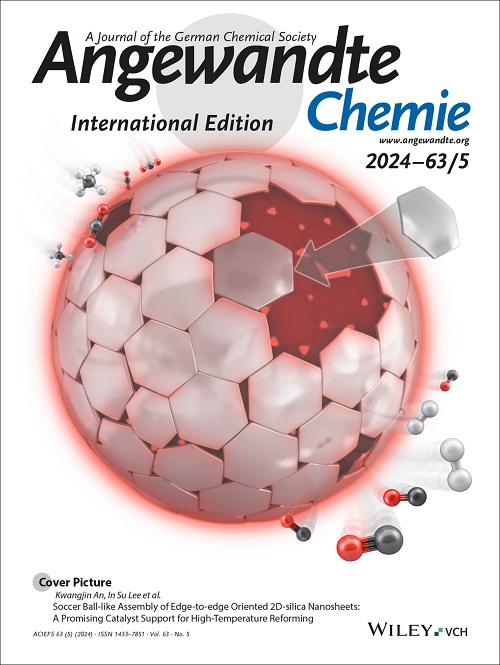Full-Color Emissive Zirconium-Organic Frameworks Constructed via in situ “One-Pot” Single-Site Modification for Tryptophan Detection and Energy Transfer
IF 16.1
1区 化学
Q1 CHEMISTRY, MULTIDISCIPLINARY
引用次数: 0
Abstract
Organic linker-based luminescent metal-organic frameworks (LMOFs) have received extensive studies due to the unlimited species of emissive organic linkers and tunable structure of MOFs. However, the multiple-step organic synthesis is always a great challenge for the development of LMOFs. As an alternative strategy, in situ “one-pot” strategy, in which the generation of emissive organic linkers and sequential construction of LMOFs happen in one reaction condition, can avoid time-consuming pre-synthesis of organic linkers. In the present work, we demonstrate the successful utilization of in situ “one-pot” strategy to construct a series of LMOFs via the single-site modification between the reaction of aldehydes and o-phenylenediamine-based tetratopic carboxylic acid. The resultant MOFs possess csq topology with emission covering blue to near-infrared. The nanosized LMOFs exhibit excellent sensitivity and selectivity for tryptophan detection. In addition, two component-based LMOFs can also be prepared via the in situ “one-pot” strategy and used to study energy transfer. This work not only reports the construction of LMOFs with full-color emissions, which can be utilized for various applications, but also indicates that in situ “one-pot” strategy indeed is a useful and powerful method to complement the traditional MOFs construction method for preparing porous materials with tunable functionalities and properties.通过原位 "一锅式 "单点修饰构建的全色发射锆有机框架,用于色氨酸检测和能量转移
基于有机连接体的发光金属有机框架(LMOFs)因其发光有机连接体种类的无限性和 MOFs 结构的可调性而得到了广泛的研究。然而,多步有机合成始终是开发 LMOFs 的巨大挑战。作为一种替代策略,原位 "一锅 "策略可在一个反应条件下生成发射型有机连接体并依次构建 LMOF,从而避免了耗时的有机连接体预合成。在本研究中,我们成功地利用了原位 "一锅 "策略,通过醛与邻苯二胺基四羧酸反应之间的单位修饰,构建了一系列 LMOFs。由此获得的 MOFs 具有 csq 拓扑结构,发射范围覆盖蓝色到近红外。这种纳米级 LMOF 在色氨酸检测方面具有极佳的灵敏度和选择性。此外,还可以通过原位 "一锅 "策略制备双组分 LMOF,并将其用于研究能量转移。这项工作不仅报道了具有全彩发射功能的 LMOFs 的构建,可将其用于各种应用,而且表明原位 "一锅 "策略确实是制备具有可调功能和性质的多孔材料的传统 MOFs 构建方法的一种有用且强大的补充方法。
本文章由计算机程序翻译,如有差异,请以英文原文为准。
求助全文
约1分钟内获得全文
求助全文
来源期刊
CiteScore
26.60
自引率
6.60%
发文量
3549
审稿时长
1.5 months
期刊介绍:
Angewandte Chemie, a journal of the German Chemical Society (GDCh), maintains a leading position among scholarly journals in general chemistry with an impressive Impact Factor of 16.6 (2022 Journal Citation Reports, Clarivate, 2023). Published weekly in a reader-friendly format, it features new articles almost every day. Established in 1887, Angewandte Chemie is a prominent chemistry journal, offering a dynamic blend of Review-type articles, Highlights, Communications, and Research Articles on a weekly basis, making it unique in the field.
文献相关原料
| 公司名称 | 产品信息 | 采购帮参考价格 |
|---|

 求助内容:
求助内容: 应助结果提醒方式:
应助结果提醒方式:


